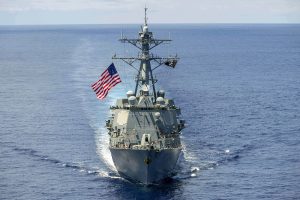What will the U.S. Navy’s next large surface combatant look like?
The USN has cycled through a wide variety of plans for its next generation large surface combatant, including both cruiser and destroyer projects. Thus far, three decades of thinking about replacing the Ticonderogas and the DDG-51 classes have resulted in the Zumwalts, a three ship class widely regarded as expensive curiosities, and a third flight of Arleigh Burke destroyers. According to David Larter, the Navy is now looking at entirely new hull that would represent a step beyond the DDG-51 in terms of size and capability. It is quite likely that the new ships will be equipped to carry and launch hypersonic weapons from construction.
The Navy’s future cruiser project also remains up in the air, but the ships will also require a larger hull. It is not inconceivable that the Navy could use the same hull for both the future cruisers and destroyers, with different constellations of systems to fulfill the missions specific to each type. The Ticonderoga class cruisers, after all, were based on the hull of the Spruance class destroyers. Larter’s reporting suggests that the Navy is focusing on a hull that can accommodate a set of already-developed technologies better than the existing DDG-51, which does not allow much room for growth. New technologies could then be incorporated into destroyers and cruisers as they develop into maturity.
In a sense, then, the Navy is trying to recapture the magic of the DDG-51. The Arleigh Burke project has been fabulously successful, generating scores of robust hulls with plenty of room for improvement and modification. A follow-on project that builds upon the success of that class would be welcome after the misfires of the DDG-1000 and LCS programs, as well as the ongoing difficulties of the CVN-78 carriers. That said, in the wake of the recent news that the USN hopes to retrofit its existing DDG-51 class destroyers to carry hypersonic missiles, it is uncertain how the Navy will find the resources to build larger ships in significant quantities. It is also unclear how the new large surface combatant will fit into the vision of a 500 ship Navy, which largely relies on substantial increases in smaller, cheaper vessels and unmanned ships.
The construction of China’s Type 055 destroyer, a third again as large as the DDG-51, has made it apparent that navies can start thinking seriously about large surface combatants again. An evolutionary development of the Type 052D, the Type 055 has a conventional design that nonetheless enables it to comfortably carry an array of modern weapons and sensors. That the USN has decided to take the same path, rather than investing heavily in radical, innovative new designs such as the Zumwalt or the stillborn CGN(X) large surface combatant suggests not only a certain degree of modesty, but also a growing concern about the Navy’s ability to match technologies to hulls.

































